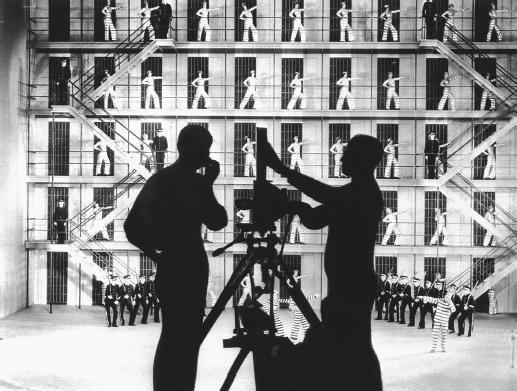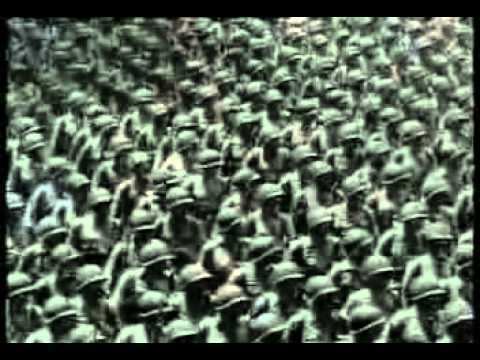The March of Time
4 /10 1 Votes4
Language English | Genre News documentary and dramatization Duration Country United States | |||||||||||||||||||||||||||||||||
 | ||||||||||||||||||||||||||||||||||
Director Arthur Pryor Jr.Donald StoufferThomas HarringtonWilliam SpierHomer Fickett Creator Roy E. LarsenFred Smith | ||||||||||||||||||||||||||||||||||
The March of Time is an American short film series sponsored by Time Inc. and shown in movie theaters from 1935 to 1951. It was based on a radio news series broadcast from 1931 to 1945. The "voice" of both series was Westbrook Van Voorhis. Produced and written by Louis de Rochemont and his brother Richard de Rochemont, The March of Time was recognized with an Academy Honorary Award in 1937.
Contents

The March of Time organization also produced four feature films for theatrical release, and created documentary series for early television. Its first TV series, Crusade in Europe (1949), received a Peabody Award and one of the first Emmy Awards.

Production

The March of Time was based on a news documentary and dramatization series, also called The March of Time, that was first broadcast on CBS Radio. Usually called a newsreel series, The March of Time was actually a monthly series of short feature films twice the length of standard newsreels. The films were didactic, with a subjective point of view. The editors of Time described it as "pictorial journalism". Like its radio namesake, The March of Time included reporting, on-location shots, and dramatic reenactments. The March of Time's relationship to the newsreel was compared to the weekly interpretive news magazine's relationship to the daily newspaper.

The March of Time was launched February 1, 1935, in over 500 theaters. Each entry in the series was either a two- or three-reel film (20 or 30 minutes). Westbrook Van Voorhis, who hosted the radio program, served as narrator of the film series. The series, which finally totalled close to 200 segments, was an immediate success with audiences. Because of its high production costs—estimated at $50,000 per episode, released at the rate of about one episode per month—the series was a money loser. However, it remained in production for six years beyond the cancellation of the radio show on which it was based.
At its peak The March of Time was seen by 25 million U.S. moviegoers a month.
"Implicit in all March of Time issues was a kind of uncomplicated American liberalism — general good intentions, a healthy journalistic skepticism, faith in enlightened self-interest, and substantial pride in American progress and potential", wrote March of Time chronicler Raymond Fielding:
The men who made the March of Time were not political theorists, they were journalists. For them, fascism, communism, and native demagogues seemed foreign to the American ethic, and they exposed and attacked them accordingly. … A cinematic agent provocateur, the March of Time turned over a lot of rocks, both at home and abroad, and illuminated the creatures it found beneath them. The demagogues and quacks whom they attacked in the 1930s may seem like obvious targets now, but they didn't seem so then. They were popular, powerful, frightening people, and the March of Time stood entirely alone in theatrical motion picture circles as a muckraker.
In late 1936, producer Roy E. Larsen reluctantly left The March of Time to serve as publisher of Life, a weekly news magazine that began publication in November 1936. Time executives had long vacillated over launching such a magazine, but the success of The March of Time's experiments in pictorial journalism overcame the hesitation of the corporation's board of directors. Larsen proposed that the new magazine be named The March of Time, but the name Life was purchased from the owners of a declining periodical. Life magazine was a great success and notable influence on photojournalism throughout its 36-year history.
Louis de Rochemont succeeded Larsen as producer of The March of Time, while Larsen continued to supervise the operations of the series on behalf of the Time corporation.
Examining the subjects of The March of Time, series historian Raymond Fielding found that episodes dealing with a single country and its affairs comprised 32.6 to 36 percent of the entire series. Economic issues were the subject of 10 percent of the episodes, and domestic politics 5 percent. Between 1935 and 1942, approximately 24 percent of the episodes were about war or the threat of war; from December 1941 until the end of World War II nearly every episode dealt with war.
"Although the March of Time was professedly nonpartisan, a clear and persistent antifascist tone was becoming apparent in its analysis of world politics and rising militarism", Fielding wrote. "'Rehearsal for War' [August 6, 1937] was unquestionably anti-Franco, which was exactly what liberal staff members had intended."
During Louis de Rochemont's tenure (1935–1943), 14 percent of the March of Time episodes were about the impact of specific individuals on political, economic and military events — a number that dropped significantly after his departure. De Rochemont's particular interest in the geopolitical role of the world's waterways resulted in 7.5 percent of all episodes devoted to the subject.
The March of Time film series ended in 1951, when the widespread adoption of television and daily TV news shows made the newsreel format obsolete. Newsreel series such as Pathé News (1910–56), Paramount News (1927–57), Fox Movietone News (1928–63), Hearst Metrotone News/News of the Day (1914–67), and Universal Newsreel (1929–67) continued for a while longer.
Episodes
Unless noted, sources for episode information are The March of Time, 1935–1951 by Raymond Fielding, and the HBO Archive's summary of The March of Time Newsreels.
Reviews and commentary
Awards and recognition
Feature films
Four feature-length films were produced by The March of Time.
Television
In 1949 The March of Time created the first extensive documentary series for television, Crusade in Europe, based on the book by Dwight D. Eisenhower. The ABC series received a Peabody Award and one of the first Emmy Awards (Best Public Service, Cultural or Educational Program). It was followed by Crusade in the Pacific (1951).
In 1965–1966, producer David L. Wolper revived the March of Time title for a series of documentary films produced in association with Time-Life, Inc. The series was not successful.
